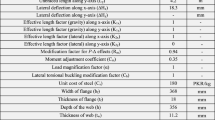Abstract
A practical method to achieve the minimum weight design of 2D steel frames, built with European standard I-shaped crosssections, is hereby presented. The optimization methodology consists of an incremental iterative technique. It is based on the addition of lacking material by successive increasing of the size of the most stressed member. Second-order effects are considered in this approach. Eurocode 3 restrictions for both the Ultimate Limit States (ULS) and Serviceability Limit States (SLS) are also taken into account. The numerical procedure has been coded in MatLab. The proposed method gives, with reasonably small computing effort, a sound approach to the exact optimum solution. An illustrative example of applying this methodology for designing a steel portal frame is presented; besides, its results are validated for a classical benchmark problem.
Similar content being viewed by others
References
Argüelles, R. (2005). Steel Structures. Analysis. 2nd edition, Bellisco, Madrid (in Spanish).
Auer, B. J. (2005). Size and shape optimization of frame and truss structures through evolutionary methods. MSC Thesis Dissertation, University of Idaho.
Blachowski, B. and Gutkowski, W. (2008). “Discrete structural optimization by removing redundant material.” Eng. Optim., 40(7), pp. 685–694.
Camp, C., Pezeshk, S., and Cao, G. (1998). “Optimized design of two-dimensional structures using a genetic algorithm.” J. Struct. Eng., 124(5), pp. 551–559.
EN 1993-1-1 (2005). Eurocode 3: Design of steel structures. Part 1-1: General rules and rules for buildings. European Committee for Standardization (CEN), Brussels.
Faria, A. R. and Hansen, J. S. (2001). “On buckling optimization under uncertain loading combinations.” Struct. Multidisc. Optim., 21, pp. 272–282.
Gil-Martín, L. M., Hernández-Montes, E., and Aschheim, M. (2006). “Optimum design of planar frames based on stability criterion using first-order analysis.” Eng. Struct., 28, pp. 1780–1786.
Gutkowski, W. and Zawidzka, J. (1997). “Sequential algorithm for discrete minimum weight design of structures.” Proc. 2nd World Congress on Struct. and Multidisc. Optim., Zakopane, pp. 313–318.
Guerlement, G., Targowski, R., Gutkowski, W., and Zawidzka, J. (2001). “Discrete minimum weight design of steel structures using EC3 code.” Struct. Multidisc. Optim., 22, pp. 322–327.
Hall, B. S. (2005). Genetic Algorithm Based Optimization of Steel Moment Frames: A Case Study. MSC Thesis Dissertation, North Carolina State University.
Hayalioglu, M. S. (2001). “Optimum load and resistance factor of steel space frames using genetic algorithm.” Struct. Multidisc. Optim., 21, pp. 292–299.
Mahfouz, S. Y. (1999). Design optimization of steel frame structures according to the British codes of practice using a Genetic Algorithm. Ph.D. Thesis Dissertation, University of Bradford.
SAP2000 (2010). SAP2000 Analysis Reference Manual. Computers and Structures Inc., Berkeley.
Surovek-Maleck, A. and White, D. W. (2004). “Alternative approaches for elastic analysis and design of steel frames I.” J. Struct. Eng., 130(8), pp. 1186–1205.
Spain’s Ministry for Housing (2006). Technical Code for Building (CTE). Parts I and II, Madrid, Spain (in Spanish).
Papadrakakis, M., Lagaros, N. D., and Plevris, V. (2005). “Design optimization of steel structures considering uncertainties.” Eng. Structures, 27, pp. 1408–1418.
White, D. W. and Hajjar, J. F. (1991). “Application of second-order elastic analysis in LRFD.” Eng. J., pp. 133–148.
Author information
Authors and Affiliations
Corresponding author
Additional information
Note.-Discussion open until August 1, 2014. This manuscript for this paper was submitted for review and possible publication on March 27, 2012; approved on January 24, 2014.
Rights and permissions
About this article
Cite this article
Mosquera, J.C., Gargoum, L.A. A sequential algorithm for minimum weight design of 2-D steel portal frames using Eurocode 3. Int J Steel Struct 14, 141–149 (2014). https://doi.org/10.1007/s13296-014-1012-6
Published:
Issue Date:
DOI: https://doi.org/10.1007/s13296-014-1012-6



